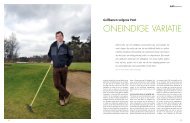restoring Royal Hague's greens - Infinite Variety Golf Design
restoring Royal Hague's greens - Infinite Variety Golf Design
restoring Royal Hague's greens - Infinite Variety Golf Design
You also want an ePaper? Increase the reach of your titles
YUMPU automatically turns print PDFs into web optimized ePapers that Google loves.
<strong>Royal</strong> Hague: The 462-metre<br />
par-5 first hole plays a lot<br />
shorter than its distance would<br />
indicate; its green is also one of<br />
the more ‘friendly’ on the<br />
course—the hallmarks of a<br />
typical Alison-style opening<br />
hole. The fourth green shares a<br />
deep, grassy hollow with the<br />
first hole. (Photograph by<br />
Frank Pont.)<br />
OPPOSITE <strong>Royal</strong> Hague:<br />
Defined by a ‘blind’ tee-shot<br />
over a towering dune to a wide<br />
fairway, the 345-metre par-4<br />
seventh hole is the kind that<br />
isn’t built anymore. Don’t be<br />
fooled by the hole’s width:<br />
successful tee-shot positioning<br />
is everything here, enabling<br />
golfers to attack the flag. This<br />
especially holds sway when the<br />
pin is on the new, expanded<br />
right-hand side of the green.<br />
(Photograph by Frank Pont.)<br />
was being a perennial maintenance nightmare<br />
for the greenkeepers. We decided the<br />
tree had to go, and that it would be replaced<br />
by a new bunker, which also would increase<br />
the number of <strong>greens</strong>ide bunkers to three. To<br />
further amplify the interest of the hole, the<br />
valley situated before the green was widened.<br />
In this manner, shots into the green that were<br />
short, including drives, would roll all the way<br />
down to the right of the fairway. From this<br />
area, recovery shots can be delicate, tricky or<br />
downright murderous depending on one’s<br />
short game skill.<br />
The final par-3 of the course, the seventeenth<br />
hole, represents the last of <strong>Royal</strong><br />
Hague’s new <strong>greens</strong>. The hole suffered<br />
through having its previous green poorly visible<br />
from the tee; it didn’t assimilate in the<br />
existing landscape, and the green only yielded<br />
a few interesting pin positions. In designing<br />
the new green, along with its surrounding<br />
landforms, we wanted to achieve a number of<br />
outcomes: the front part of the green should<br />
be sloping upward to enhance visibility from<br />
the tee; the back-left part of the green should<br />
be lower than the top plateau to create a hardto-hit<br />
target; it should be more harmonious<br />
with the surrounding landscape. Lastly, we<br />
wanted to incorporate three bunkers, each<br />
with various degrees of difficulty and flashedsand<br />
faces, to make the defence of the hole<br />
more varied. Additional strengthening of the<br />
hole was achieved after we constructed a<br />
number of low, grassy hollows behind, and to<br />
the right of, the green. And last, but not of<br />
least importance, we allowed for a less-risky<br />
‘bail-out’ area for the benefit of older members<br />
in the front, left of the green. Now, a relatively<br />
easy chip onto the green is possible.<br />
The fortitude that <strong>Royal</strong> Hague displayed<br />
in having all its <strong>greens</strong> restored has paid off<br />
handsomely. Not only are the putting surfaces<br />
back to their original high standards<br />
and presenting firm and fast <strong>greens</strong>, but<br />
there is real excitement around the club<br />
knowing that it now possesses one of the<br />
most exciting inward nine holes one could<br />
ever hope to play. The ‘sleeping beauty’ that<br />
Alison created has truly woken up; may she<br />
live a long and happy life.<br />
242 GOLF ARCHITECTURE: A WORLDWIDE PERSPECTIVE – VOLUME FIVE









